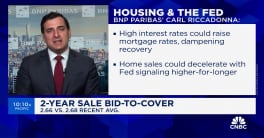The initial report which came out in February 2005 examined the historical
pattern of housing booms and busts in America's metropolitan areas. "Boom
markets" were defined as those in which inflation adjusted prices
for homes rose by 30 percent or more in a three year period and "busts"
occurred when home prices had declined by at least 15 percent over a five-year
period. The February report looked at the period from 1978 through 2003 and
found that 63 cities had experienced a real estate boom during that period and
that 33 cities were in the throes of a boom at the end of 2003. The study concluded
that a housing boom does not necessarily lead to a real estate market
crash. While 21 housing busts have occurred since 1978, only 9 of them
happened in the wake of a housing market bubble.
The study reached two other conclusions. The first was that those housing
bubble bursts that occurred almost always followed significant distress
in the local economy. In other words, even if a real estate bubble burst
followed a home price bubble, the former may have had little
to do with the prior run-up of housing prices but were aligned more with underlying
economic factors. The second conclusion was that the manner in which a boom
ends matters most to mortgage lenders and homeowners or investors. The most
common historical way for a housing boom to end was through a period of price
stagnation which allowed the local economy to catch up with inflated home
prices.
The FDIC revised its February report in early May, using recently released data for 2004 from the Office of Federal Housing Enterprise Oversight (OHFEO.) The OHFEO study, as reported here last month, found that the average U.S. home price rose by almost 11 percent in 2004, up from 7 percent in both 2002 and 2003 and that the number of boom markets (according to FDIC definitions) increased by 72 percent last year to now include 55 metropolitan areas. These housing bubble markets included 21 cities in California, 18 in the Northeast and New England (New York), and 11 in Florida.
The FDIC report notes that the increase in home prices in 2004 outstripped the improvement in underlying economic fundamentals. For example, rental rates increased by only 2.7 percent nationwide in 2004 and 2.4 percent in 2003, far below the 11 and 7 percent increases in sale prices in those two years. Also, housing prices in 2004 increased at nearly twice the rate of personal income (5.8 percent). Personal income grew 4.2 percent in 2003.
The FDIC also quotes the National Association of Realtors housing affordability index for first-time homebuyers which uses home prices, incomes, and interest rates to measure the ability to enter the housing market. That index slipped 3.8 points in 2004 to 77.7. This index equals 100 when median family income will qualify for an 80 percent mortgage on an existing median priced single family home.
FDIC makes a pretty good case through its numbers that the home sale market is overheated but says little beyond "it hardly ever happens" to explain what the future might bring.
The Corporation which insures and to an extent regulates the nations' banks has good reason to hope that it won't soon encounter the kind of real estate downturn that most recently occurred in 1990-1993. At that time the Corporation was forced to close some 300 banks, largely in the Northeast and California. This was merely the frosting on the massive savings and loan mess which forced closure of over 750 S&Ls throughout the Midwest and Southwest. FDIC initially had nothing to do with managing that ugliness which had its roots in agricultural and energy based loans although they did ultimately assume responsibility from the Resolution Trust Corporation for final liquidation of the assets of the failed S&Ls.
But the FDIC still had its hands full. The failure of the banks was largely due to their unbridled enthusiasm for real estate and FDIC inherited billions in real estate secured loans and bank owned (foreclosed) properties from the banks it closed. Clearing it all up took almost a decade and nearly bankrupted the bank insurance fund.
It would have been helpful had the FDIC drawn some parallels between the current housing market bubble and the boom of the mid to late 1980's which was followed by a significant housing crash. The market of today is quite different on a number of counts than what happened then, a topic that is worth exploring.
Because of the differences, there is reason to hope that the current situation will gradually run out of steam so that nobody gets hurt. Then again, maybe the two FDIC reports coming in such quick succession are a form of whistling past the graveyard.







